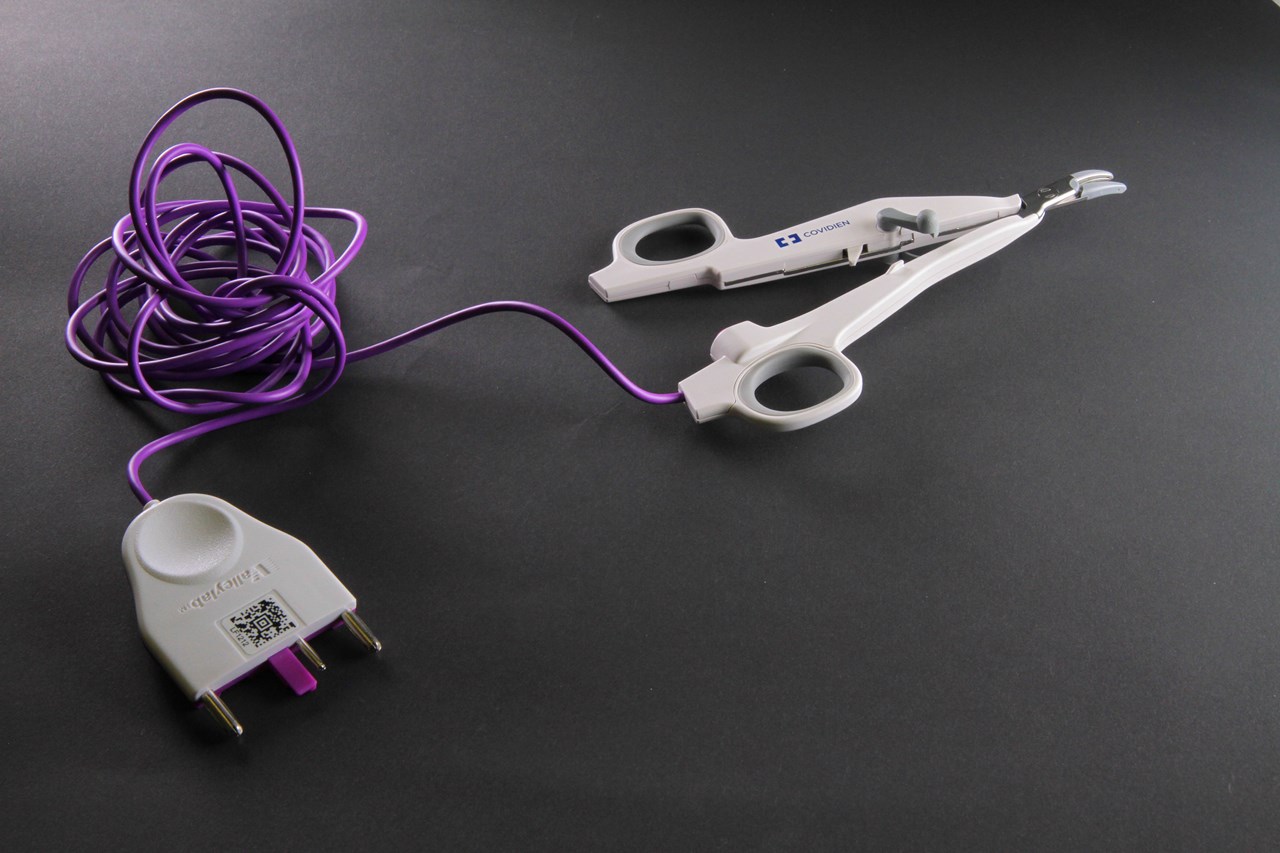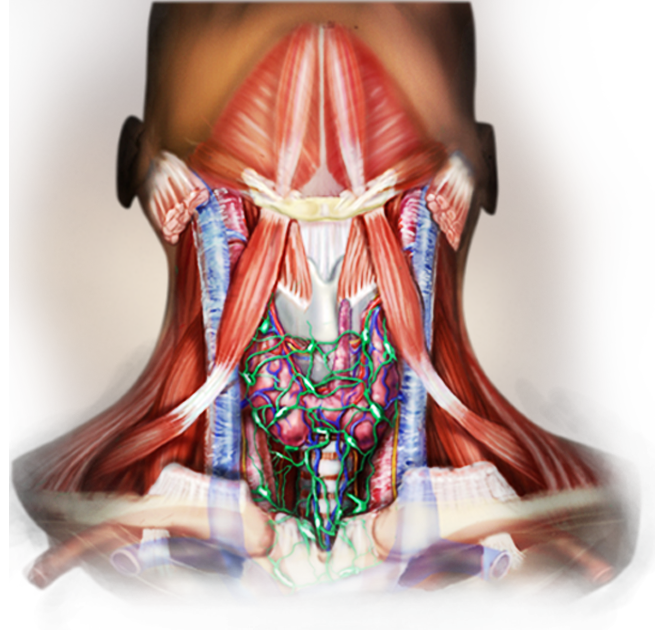
Thyroidectomy
Application of LigaSure™ Small Jaw Instrument
Program Outline
The purpose of this online eLearning module is to outline advanced bipolar energy, the LigaSure™ Small Jaw Instrument, in use during thyroidectomy for the management of thyroid disease.
The 25-minute online module will review basic principles of advanced bipolar energy; surgical techniques and tips for safe and efficacious use; and evidence-based research on the use of the LigaSure™ Small Jaw Instrument in a patient undergoing thyroidectomy with regards to operating time, blood loss and patient discharge.
Program objectives
- Understand the clinical literature regarding advanced energy use in thyroidectomy.
- Know how to identify and address common problems encountered while using advanced energy in thyroidectomy.
- Know how to minimize common postoperative complications.
- Know technical tips for advanced energy used during thyroidectomy.
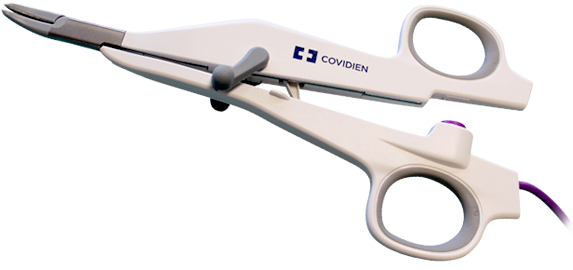
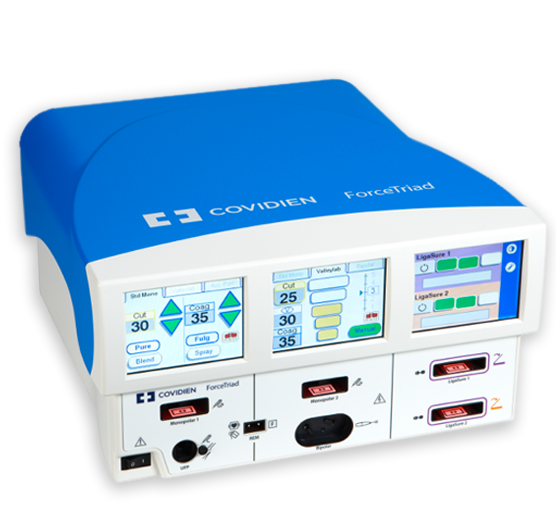
Energy Sources
Advanced Energy
- Butskiy O, Wiseman SM. Electrothermal bipolar vessel sealing system (LigaSure) for hemostasis during thyroid surgery: a comprehensive review. Expert Rev Med Devices 2013;10:389-410. PubMed
- Parmeggiani D, De Falco M, Avenia N, Sanguinetti A, Fiore A, Docimo G, Ambrosino P, Madonna I, Peltrini R, Parmeggiani U. Nerve sparing sutureless total thyroidectomy. Preliminary study Ann Ital Chir. 2012 ;83:91-6. PubMed
- Dionigi G, Boni L, Rausei S, Frattini F, Ferrari CC, Mangano A, Leotta A, Franchin M. The safety of energy-based devices in open thyroidectomy: a prospective, randomised study comparing the LigaSure (LF1212) and the Harmonic® FOCUS. Langenbecks Arch Surg. 2012;397:817-23. PubMed
- Rahbari R, Mathur A, Kitano M, Guerrero M, Shen WT, Duh QY, Clark OH, Kebebew E. Prospective randomized trial of ligasure versus harmonic hemostasis technique in thyroidectomy. Ann Surg Oncol. 2011;18:1023-7. PubMed
- Saint Marc O, Cogliandolo A, Piquard A, Famà F, Pidoto RR. LigaSure vs clamp-and-tie technique to achieve hemostasis in total thyroidectomy for benign multinodular goiter: a prospective randomized study. Arch Surg. 2007 Feb;142:150-6. PubMed
Strasbourg (FRANCE)


Operative Technique
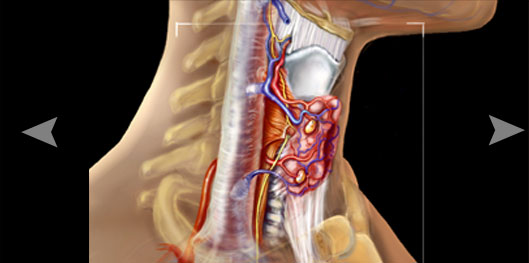
The description of the minimally invasive video-assisted thyroidectomy covers all aspects of the surgical procedure used for the management of thyroid nodules.
Operating room set up, position of patient and equipment, instruments used are thoroughly described. The technical key steps of the surgical procedure are presented in a step by step way: dissection, ligatures, extraction/resection.
Consequently, this operating technique is well standardized for the management of this condition.
Strasbourg (FRANCE)

- 1. IntroductionEver since endoscopic parathyroidectomy was first reported (Gagner, 1996), video-assisted techniques have been applied to surgery of the neck. Several series (Miccoli et al., 2000; Henry et al., 1999) have documented the feasibility of these approaches for parathyroid and thyroid disease.
The first endoscopic procedures for the removal of small thyroid nodules were introduced in 1998 (Miccoli et al., 2001a; Ohgami et al., 2000; Shimizu et al., 1999). These procedures have not become widespread because the advantages of this kind of minimally invasive surgery are less evident than in abdominal surgery. This is particularly true for thyroidectomy, as the open procedure is well standardized. The major disadvantage of these minimally invasive procedures lies in the limited number of patients who can benefit from them, especially in endemic goiter areas. Moreover, operative times and complication rates are expected to be higher at the beginning, as in every new minimally invasive procedure. Costs and technology gaps can also be deterrents to the use of these techniques.
Thyroid surgery is widely used. This chapter describes a conventional and well-standardized surgical technique allowing for minimal parathyroid and recurrent risks. This technique is safe, reproducible in most cases. The technique has been adapted and tailored according to Charles Proye’s principles. The use of modern hemostatic means makes it possible to reduce operative time and to prevent any potential risks. The technique may be used in all types of benign or malignant thyroid conditions. - 2. Anatomy
- • Embryology1. First pharyngeal pouch
2. Second pharyngeal pouch
3. Epithelial cord
4. Thyroid gland
The thyroid gland begins to form around the 17th day of development between the first and the second pharyngeal pouches. The glandular primordium rapidly forms an epithelial cord, which penetrates the floor of the oral cavity and, losing its connection with the pharyngeal floor, reaches the anterior side of the trachea.
At this point, the tip of the duct bifurcates and subsequently spreads out transversely into 2 lateral lobes. In certain cases, the duct may persist partially as a thyroglossal cyst. - • Surgical anatomy1. Right lobe
2. Left lobe
3. Isthmus
4. Pyramidal lobe
5. Capsule
6. Berry’s ligament
7. Sternothyroid muscle
8. Sternohyoid muscle
The thyroid gland consists of 2 lobes joined by an isthmus. The normal weight of the adult gland is around 20 g. Each lobe has a conical shape and measures about 2 x 3 x 5 cm. A normal thyroid is dark wine-red in color, soft, and covered by a thin capsule.
The gland is situated in the lower aspect of the neck with the isthmus crossing the trachea at the level of the second and the third tracheal ring. The posterior suspensory ligament (Berry’s ligament) attaches the gland to this structure.
The gland is covered by the strap muscles (sternohyoid and sternothyroid muscles), joined in the midline by the cervical linea alba (anterior fascia cervicalis). The medial aspect of each lobe lies over the larynx and the trachea. The esophagus is situated on the posteromedial aspect of the thyroid lobe, and the recurrent nerve runs more or less vertically along the tracheo-esophageal groove. The superior poles are in contact with the inferior constrictor muscle and the posterior aspect of the cricothyroid muscle. The inferior pole usually reaches the fourth or fifth tracheal ring. Often a remnant of the thyroglossal duct extends cranially from the isthmus and is variably developed (pyramidal lobe). - • Blood supply1. External carotid artery
2. Superior thyroid artery
3. Superior laryngeal nerve
4. Inferior thyroid artery
5. Thyrocervical trunk
6. Inferior laryngeal nerve
7. Inferior parathyroid gland
8. Superior parathyroid gland
9. Superior thyroid vein
10. Middle thyroid vein
11. Inferior thyroid vein
The gland receives its arterial blood supply from the superior and inferior thyroid arteries. The superior thyroid artery originates from the external carotid artery. It descends along the surface of the inferior constrictor of the pharynx and enters the upper pole of the thyroid on its anterior superior surface. In about 10% of cases, a branch of this artery feeds the superior parathyroid gland. The external branch of the superior laryngeal nerve runs very close to the branches of the superior thyroid artery, even though this relationship is quite variable.
The inferior thyroid artery is a branch of the thyrocervical trunk; it passes behind the common carotid artery and jugular vein, toward the cricoid cartilage. At the level of the gland, the artery loops downward and medially and enters the middle aspect of the lobe. It divides into several terminal branches. This artery and its branches have a very close relationship with the inferior laryngeal nerve. A branch of the inferior thyroid artery usually feeds the inferior parathyroid gland; in most cases, the inferior thyroid artery supplies also the superior parathyroid gland. A thyroid artery (thyroidea ima artery) is rarely present: it arises from the innominate artery and enters the isthmus.
The venous drainage is more variable than the arterial supply. The superior thyroid vein is closely related to the superior thyroid artery and drains into the internal jugular vein. Middle thyroid veins vary in number and pass from the lateral border of the lobe into the internal jugular vein. The inferior veins are separate from the inferior thyroid arteries and drain the inferior lobes into the internal jugular or innominate veins. - • Lymphatic drainage1. Central compartment
2. Lateral compartment
3. Innominate vein
4. Trachea
5. Carotid
The lymphatic drainage of the thyroid gland is very extensive. The surgeon has to consider 2 main zones of lymphatic drainage: central compartment (periglandular space) and lateral compartment. The carotid sheet separates the 2 compartments.
The central compartment includes the prelaryngeal, pretracheal, and paratracheal-esophageal groups. The strap muscles constitute the anterior boundary of this compartment. There is a large connection between the 2 compartments and the 2 sides due to the existence of a capsular network, which is in communication with the deep lymphatic vessels. The central compartment is delimited by the innominate vein inferiorly, by the trachea medially and by the carotid laterally. - • Laryngeal nerves
- • Superior1. Superior laryngeal nerve
2. Superior thyroid pole
3. Middle constrictor muscle
4. External branch of superior laryngeal nerve
5. Internal branch of superior laryngeal nerve
6. Cricothyroid muscle
The external branch of the superior laryngeal nerve is in close contact with the superior thyroid vessels and the superior thyroid pole. The superior laryngeal nerve arises from the vagus nerve and descends to lie on the middle constrictor muscles. At this level, it divides into external and internal branches. The external branch continues inferiorly and innervates the cricothyroid muscle. This muscle produces tension of the vocal cord; injuries of the external branch may thus lead to the compromise of higher-pitched vocal sounds. In 6% to 18% of cases (Berti et al., 2002), the external branch of the superior laryngeal nerve runs with or around the superior thyroid artery or its branches and so is susceptible to injury during surgical dissection. In almost 20% of cases (Berti et al., 2002), it is not situated in the surgically accessible area around the superior pole of the thyroid gland and cannot be visualized during conventional surgery; with the endoscope, optical magnification and the 30° angle allows for exposure of the entire anterior surface of the cricothyroid muscle. Thus its preparation is easily achieved during video-assisted procedures; in case its course makes its visualization impossible, the superior thyroid artery should be ligated selectively and very close to the capsule of the thyroid. - • Inferior1. Inferior laryngeal nerve
2. Vagus nerve
3. Right subclavian artery
4. Aortic arch
The inferior laryngeal nerve arises from the vagus nerve and supplies all muscles of the larynx except the cricothyroid muscle. On the right side, the nerve surrounds posteriorly the subclavian artery. On the left side, the nerve passes around the aortic arch. Both nerves run cranially and medially, toward the cricoid cartilage where it enters the larynx. The inferior laryngeal nerve is not a single strand but usually splits into several branches (to the esophagus, trachea, thyroid), and anastomoses with other nervous structures (superior laryngeal nerve, sympathetic system, contralateral nerve). The relationship between the inferior thyroid artery and the inferior laryngeal nerve is very variable. The latter may pass anteriorly, posteriorly or between the branches of the artery. In less than 1% of cases (Henry et al., 1988), the nerve does not recur on the right side and originates directly from the vagus on the neck, reaching the larynx running more or less transversely. This variation is determined by a vascular anomaly during embryonic development, resulting in an aberrant subclavian artery (arteria lusoria), originating directly from the aortic arch on the left of the left subclavian artery and passing transversely posterior to the esophagus. This anomaly is exceptional on the left side and happens in cases of situs viscerum inversus and associated vascular anomaly. - 3. IndicationsConventional thyroidectomy remains the gold standard in the treatment of most benign or malignant thyroid pathologies. Minimally invasive techniques allow to treat well-targeted conditions and cannot be used in all cases.
- 4. Preop periodPrincipal requirements
Blood tests: to control thyroid hormone levels and to potentially detect a thyroiditis.
Ultrasonography: to assess gland volume and the potential presence of suspicious lymph nodes.
Fine needle aspiration biopsy (FNAB): to assess the type of nodule (benign, malignant, suspicious). - 5. Operating room set-up
- • Patient- supine position with neck hyperextension;
- conventional neck preparation and draping;
- a sterile drape covering the skin.
- • Team1. The surgeon stands on the patient’s right side.
2. The first assistant stands opposite the surgeon.
3. The second assistant stands on the surgeon’s right side.
4. The scrub nurse stands on the first assistant’s left side, opposite the surgeon.
- • EquipmentHere is the required equipment:
1. Operating table
2. Anesthetic equipment
3. Electrocautery generator
4. LigaSure™ Precise Small Jaw
No ultrasound generator is required.
- 6. Instrumentation1. Two clawed forceps
2. Two standard forceps
3. One hemostatic forceps
4. Electrocautery/One electric scalpel
5. One LigaSure™ Precise Small Jaw
6. One right-angled forceps
7. One pair of scissors
8. One clip applier
9. Sutures for flap suspension
10. Four Farabeuf retractors
11. Two Langenbeck retractors
12. Two atraumatic traction forceps
13. One needle holder
14. One Kelly clamp - 7. Thyroid gland dissection
- • Neck preparation
- • Skin incisionAn incision adapted to the size of the injury is performed 2cm above the sternal notch. The subcutaneous tissue is incised.
- • Subcutaneous tissue dissection
- • Skin flap suspensionA superior skin flap is dissected by means of electrocautery. Traction is placed on this flap to allow for adequate exposure of the cervical region.
- • Opening of jugulocarotid gutter
- • SCM muscle dissectionThe internal border of the sternocleidomastoid (SCM) muscle is dissected in order to skeletonize the anterior aspect of the jugular vein.
- • Omohyoid muscle dissectionThe internal border of the omohyoid muscle is dissected.
- • Division of middle vein
- 8. Right lobe
- • Identification of inferior thyroid artery and recurrent nerveThe space between the jugular carotid vein package and the thyroid gland is dissected. Retractors placed on the carotid artery and on the thyroid gland make it possible to skeletonize the inferior thyroid artery and to search for the recurrent nerve.
- • Division of prethyroid musclesWhen these two muscle structures have been identified, they are divided using the LigaSure™ Precise Small Jaw.
- • Upper pole dissection
- • Upper pole dissectionThe upper pole of the gland is then approached. Anterior and lateral aspects of the thyroid gland are then dissected in order to be separated from prethyroid muscles.
- • Division of upper pole vesselsUpper pole vessels are dissected and divided.
- • Dissection of right upper lobeThe superior laryngeal nerve is identified and preserved. Upper pole vessels are divided by means of the LigaSure™ Precise Small Jaw.
- • Dissection of gland’s lower poleThe lower pole of the gland is now accessed. Vessels are dissected and divided.
- • Parathyroid dissection
- • Dissection of inferior parathyroid glandThe thyroid gland can then be retracted in order to expose its lateral aspect. Parathyroid glands are searched for and lowered. The inferior parathyroid gland will be searched for anteriorly to the junction between artery and nerve. If it is not found in an orthotopic position, it will be searched for at the upper and posterior part of the thyrothymic gutter.
- • Dissection of superior parathyroid glandThe superior parathyroid gland is found at the uppermost insertion branch of the superior thyroid artery.
- • End of gland’s dissection
- • Lowering of laryngeal nerve
- • Freeing of right lobe
- 9. Left lobe
- • Upper pole dissection
- • Vascular and nerve dissection
- • Freeing of the upper pole
- • Lateral dissection
- • Lower thyroid artery and recurrent nerve dissection
- • Recurrent nerve dissectionThe recurrent nerve is then dissected in order to be lowered. The lobe can be separated from the contralateral lobe by means of the LigaSure™ Precise Small Jaw.
In case of total thyroidectomy, similar steps are repeated in the same chronological order.
- 10. Thyroid gland resection and wound closure
- • End of dissection
- • Drainage and flap closure
- 11. ConclusionThis surgical technique is conventional and can be used in all thyroid conditions. The different principles for lymph node dissection in case of thyroid cancer are not described. Likewise, in case of voluminous or even plunging goiters, this technique will have to be adapted depending on the bulk and position of the goiter.
- 12. ReferencesBertt P. Materazzi G, Conte M, Galleri D, Miccoli P. Visualization of the external branch of the superior laryngeal nerve during video-assisted thyroidectomy. J Am Coll Surg 2002; 195:573-4. pubmed
Dralle H, Damm l, Scheumann GF, Kotzerke J, Kupsch E, Geerlings H et al. Compartment-oriented microdissection of regional lymph nodes in medullary thyroid carcinoma. Surg Today 1994:24:112-21. pubmed
Gagner M. Endoscopic subtotal parathyroidectomy in patients with primary hyperparathyroidism. Br J Surg 1996,83:875. pubmed
Henry JF, Audiffret J, Denizot A, Plan M. The nonrecurrent inferior laryngeal nerve: review of 33 cases, including two on the left side. Surgery 1988,104:977-84. pubmed
Henry JF, DeTechereux T, Gramatica L, de Boissezon C. Minimally invasive videoscopic parathyroidectomy by latéral approach. LangenbecksArch Surg 1999:384:298-301. pubmed
Miccoli P, Berti P, Raffaelli M, Conte M, Materazzi G, Galleri D. Minimally invasive video-assisted thyroidectomy. Am J Surg 2001 a; 181:567-70. pubmed
Miccoli P. Berti P, Raffaelli M, Materazzi G, Baldacci S, Rossi G. Comparison between minimally invasive video-assisted thyroidectomy and conventional thyroidectomy: a prospective randomized study. Surgery 2001b;130:1039-43. pubmed
Miccoli P. Bellantone R, Mourad M, Walz M, Raffaelli M, Berti P. Minimally Invasive Video-assisted Thyroidectomy: Multiinstitutional Experience. World J Surg 2002a;26:972-5. pubmed
Miccoli P. Elisei R, Materazzi G, Capezzone M, Galleri D, Pacini F et at. Minimally invasive video-assisted thyroidectomy for papillary carcinoma: a prospective study about its œmpleteness. Surgery, 2002b;132:1070-3; discussion 1073-4. pubmed
Miccoli P. Berti P, Conte M, Raffaelli M, Materazzi G'' Minimally invasive video-assisted parathyroidectomy: lesson learned from 137 cases. J Am Coll Surg 2000:191:613-8. pubmed
Ohgami M, Ishii S, Arisawa Y, Ohmori T, Noga K, Furukawa T et a/ Scariess endoscopic thyroidectomy: breis't approach for better cosmesis. Surg Laparosc Endosc Percutan Tech 2000; 10:1-4. pubmed
Shimizu K, Akira S, Jasmi AY, Kitamura Y, Kitagawa W, Akasu H et al. Video-assisted neck surgery: endoscopic resection of thyroid tumors with a very minimal neck wound. J Am Coll Surg 1999:188:697-703. pubmed

Expert Opinions
- Lepner U, Vaasnat T. Ligasure vessel sealing system versus conventional vessel ligation in thyroidectomy. Scand Journal Surg 2007:96;31-4. PubMed
- Covidien. Internal document. DSCHOW 7-5-12.
- Kim FJ, Chammas MF, Gewehr E, Morihisa M, Caldas F, Hayacibara E, Baptistussi M, Meyer F, Martins AC. Temperature safety profile of laparoscopic devices: Harmonic ACE (ACE), Ligature V (LV), and plasma trisector (PT). Surg Endosc 2008:22:1464-9. PubMed
- Scilletta B, Cavallaro MP, Ferlito F, Li Destri G, Minutolo V, Frezza EE, Di Cataldo A. Thyroid surgery without cut and tie: the use of Ligasure for total thyroidectomy. Int Surg 2010;95:293-8. PubMed
- Miccoli P, Davis T. Thyroid Surgery: Preventing and Managing Complications. Wiley-Blackwell Oxford 2013. Google Books
Università degli Studi di Pisa, Italy

Strasbourg (FRANCE)


Surgical Procedure
Parathyroidectomy
Parathyroid surgery has profoundly evolved through the progress of imaging techniques. Twenty years ago, surgical cervical exploration was the only method that allowed to identify parathyroid adenomas in more than 95% of cases. Since then, ultrasonography is performed using high definition. 99mTc-sestamibi (MIBI) scintigraphy helped to detect adenomas in a morphofunctional fashion. CT-scan has also evolved. The IRCAD training center's computer science department has developed a specific imaging software that allows to virtually reconstruct the different cervical organs in three dimensions from a mere injected CT-scan. 3D reconstruction helps to precisely localize the parathyroid adenoma in relation to adjacent structures, and particularly to vascular structures. This video perfectly illustrates the benefit of such 3D reconstruction which allows to intraoperatively correct a first impression. A first small-sized adenoma is rapidly found but it does not correspond to the reconstructed image, and especially so because of its relationships with the inferior thyroid artery. The dissection of the superior region of the artery, guided by 3D reconstruction allows to identify the adenoma suspected by the imaging investigation. The benefit of the imaging has allowed to carry on cervical exploration using a video-assisted approach and the patient's healing.
Strasbourg (FRANCE)

Strasbourg (FRANCE)



Faculty Experts

Università degli Studi di Pisa, Italy




Media Library
Videos
Photos
References
2. Franko J, Kish KJ, Pezzi CM, Pak H, Kukora JS. Safely increasing the efficiency of thyroidectomy using a new bipolar electrosealing device (LigaSure) versus conventional clamp-and-tie technique. Am Surg. 2006 Feb;72(2):132-6. PubMed
3. Fujita T, Doihara H, Ogasawara Y, Shimizu N. Utility of vessel-sealing systems in thyroid surgery. Acta Med Okayama. 2006 Apr;60(2):93-8. PubMed
4. Kirdak T, Korun N, Ozguc H. Use of ligasure in thyroidectomy procedures: Results of a prospective comparative study. World J Surg. 2005 Jun;29(6):771-4. PubMed
5. Lepner U, Vaasna T. Ligasure vessel sealing system versus conventional vessel ligation in thyroidectomy. Scand J Surg. 2007;96(1):31-4. PubMed
Acknowledgment
The entire WeBSurg team would like to express their warm thanks to all the surgeons who took an active part in this project for their innovative work, and notably Dr. Michel Vix, Dr. Silvana Perretta, and Professor Didier Mutter. Special thanks go to Professor Paolo Miccoli for his major contribution to this e-learning module.
We also want to thank Covidien, manufacturer and supplier of the LigaSure™ Small Jaw Instrument system, for making it possible to develop this e-learning instructional package.
We wish to congratulate Donna S. Watson (Course Curriculum Development Officer at Covidien) and Fiona Morrison (Senior Director, Global PACE Surgical Solutions at Covidien) who kindly answered all our queries about the LigaSure™ Small Jaw Instrument and who helped us putting together this e-learning module. Finally, we are grateful to Professor Jacques Marescaux for his continued support and sheer talent.

 English ▼
English ▼ Français
Français Deutsch
Deutsch Italiano
Italiano Español
Español Portuguese
Portuguese 简体中文
简体中文

 Energy sources
Energy sources Expert opinions
Expert opinions Surgical procedure
Surgical procedure Clinical Experience Using Multifunctional LigaSure™ Small Jaw
Clinical Experience Using Multifunctional LigaSure™ Small Jaw LigaSure™ Small Jaws Instrument
LigaSure™ Small Jaws Instrument LigaSure™ Small Jaws brochure
LigaSure™ Small Jaws brochure Self-study guide Electrosurgery
Self-study guide Electrosurgery






